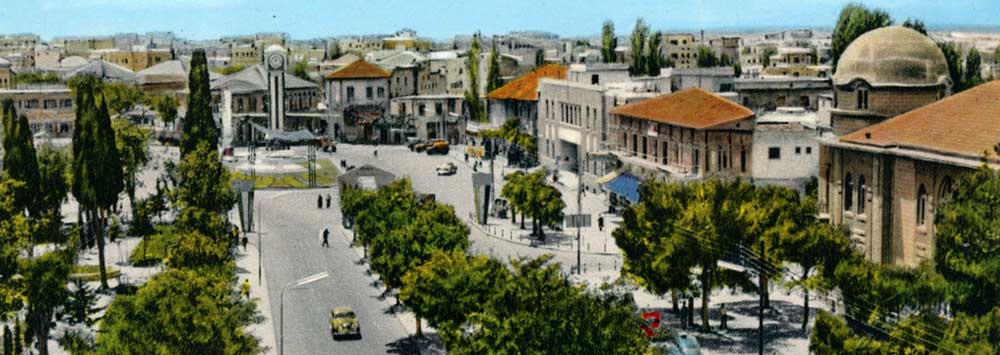by Norbert Schiller
Like many other population centers in Syria, Homs was haunted by the specter of Hafez al Assad, Bashar’s father, whose statue loomed large at the entrance of the city. Although the older Assad had been dead since the year 2000, his presence continued to be felt throughout the country because of all the statues erected in his memory.
Before the civil war, the old center of Homs was similar to that of Aleppo, but on a much smaller scale. During the Abbasid dynasty which began in 775, Homs had seven gates or doors leading to the old city. However, when I visited in 2005 only two remained. On a hill overlooking the old city stood the remnants of a once magnificent citadel.

Statue of Hafez al Assad at the entrance to Homs. Remaining portion of the citadel overlooking the city. Phot. Norbert Schiller
We arrived late in the afternoon and, not knowing our way around Homs, we decided to climb the hill leading to the citadel. Unlike in Aleppo, where the citadel had been almost intact until the war, all that remained of Homs’s fortress were its foundations and portions of its ancient wall. Still, the hilltop offered a stunning 360-degree view of the city that spread over a vast fertile plain irrigated by the Orontes. The city skyline was dominated by minarets and church steeples, a testimony to its religiously diverse history. After taking a few panoramic photographs from the hill, we climbed down making our way into the city center.

Mosques and churches can be seen across the skyline. Phot. Norbert Schiller
The old center of Homs was made up of a patchwork of neighborhoods from different periods, including a thriving Christian quarter similar to the one in Aleppo. Souk al Atik, the old covered bazaar in the very center, was quaint and picturesque but minute compared to its equivalent in Aleppo. When we visited in September, temperatures were still hot and the bazaar was teaming with people eager to get out and enjoy the cooler temperatures at nightfall.

The old Souk al Atik is across the street from the modern business district. Phot. Norbert Schiller
When we reached the center, I had to work fast because the sun was about to set. I walked through Homs’s modern and old sections capturing the contrasting aspects of the city. By the time I was finished, it was completely dark, but I felt satisfied with what I had accomplished.
After this lighting visit, I was determined to come back because there was so much more I wanted to see. I hoped that on my next trip I would do the city justice by taking the same quality images that I had taken of other parts of Syria. Unfortunately, the civil war broke out and I never had the chance to revisit Homs.

Shoppers inside the old covered bazaar, Soukh al Atik. Phot. Norbert Schiller
In 2014, I was in Lebanon working on a series of documentary films about Syrian refugees. We were in the village of Qaa in the northeast of Lebanon, a few kilometers from the Syrian border. All the refugees we spoke to were from Homs, just over the border. While I was packing up my gear, I struck up a conversation with the eldest daughter of a family we had just interviewed. I told her that my son was her age, and when she asked me what he was doing, I said that he was at university. She said that before the war she had been looking forward to going to university, but now she just wanted to learn basic computer skills so she could find a job and help her family financially. Since talking about the future was a bleak topic, I changed the subject and told her that I had visited Homs. This put a smile on her face and she wanted to know what I thought of her city. We discussed some of the places I had visited and when I said how much I liked the old bazaar, she turned away saying that there was nothing left of it. I asked her about a few other landmarks and she repeated that everything has been destroyed. Before I could change the subject again, she began to tear up and then covered her face to hide her emotions.
It is hard to imagine that Homs, a gem in the Syrian interior little known to the outside world, has suffered Dresden-like devastation. Its old center, which once bustled with life and activity, is now nothing but a chilling ghost town that echoes the names of the dead. Even if Homs is rebuilt under a Marshall plan for Syria, it will only be a diminished version of its former self as the city’s soul, made of hundreds of years of history, has slipped away leaving behind a bare skeleton.








